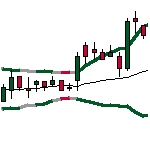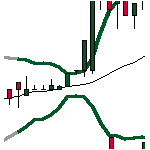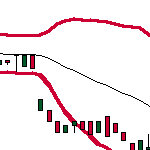iShares Russell 2000 ETF Forecast
Explanation to Bollinger's Bands
Bollinger Bands was created by John Bollinger in the early 1980s, its purpose is to define price action relative to the assets highs and lows. This technical indicator is used to identify buy and sell signals and has proven very well in doing so.
Bollinger Bands consist of a set of three curves drawn in relation to securities prices. The middle band is a measure of the intermediate-term trend, usually a simple moving average, that serves as the base for the upper and lower bands. The interval between the upper and lower bands and the middle band is determined by volatility, typically the standard deviation of the same data that were used for the average. StockInvest.us uses Bollingers suggested 20 day average.
Middle Bollinger Band = 20-period simple moving average
Upper Bollinger Band = Middle Bollinger Band + 2 * 20-period standard deviation
Lower Bollinger Band = Middle Bollinger Band - 2 * 20-period standard deviation
BandWidth defines the current width of the band.
%b defines the current position within the band.
BandWidth = (Upper Bollinger Band - Lower Bollinger Band) / Middle Bollinger Band
%b = (Last - Lower Bollinger Band) / (Upper Bollinger Band - Lower Bollinger Band)
Live Samples:



Bottlenecks in bandwidth indicate an upcoming change. Break up through the moving average line or continuous movements above the moving average line indicate a break up, and vice versa.
Source: http://www.bollingerbands.com
Stronger technical forecast for iShares Russell 2000 ETF price after Wednesday trading.
(Updated on Apr 24, 2024)
The iShares Russell 2000 ETF price fell by -0.378% on the last day (Wednesday, 24th Apr 2024) from $198.44 to $197.69. During the last trading day the ETF fluctuated 1.25% from a day low at $196.46 to a day high of $198.91. The price has fallen in 6 of the last 10 days and is down by -1.6% for this period. Volume fell on the last day along with the ETF, which is actually a good sign as volume should follow the ETF. On the last day, the trading volume fell by -4 million shares and in total, 27 million shares were bought and sold for approximately $5.25 billion.
The ETF is moving within a horizontal trend and further movements within this trend can be expected. Given the current horizontal trend, you can expect iShares Russell 2000 ETF with a 90% probability to be traded between $196.84 and $215.65 at the end of this 3-month period. A break of a horizontal trend is often followed by a large increase in the volume, and ETFS seldom manage to go directly from the bottom of a trend up to the top. ETFS turning up in the middle of a horizontal trend are therefore considered to be potential runners.
Ready to grow your portfolio? Here's your beginner's guide to opening a free brokerage account.
IWM Signals & Forecast
A buy signal was issued from a pivot bottom point on Thursday, April 18, 2024, and so far it has risen 2.55%. Further rise is indicated until a new top pivot has been found. Some negative signals were issued as well, and these may have some influence on the near short-term development. The iShares Russell 2000 ETF holds a buy signal from the short-term Moving Average; at the same time, however, the long-term average holds a general sell signal. Since the longterm average is above the short-term average there is a general sell signal in the ETF giving a more negative forecast for the stock. On further gains, the ETF will meet resistance from the long-term Moving Average at $202.68. On a fall, the ETF will find some support from the short-term average at $195.05. A break-up through the long-term average will give another buy signal, while a fall below the short-term average will add another sell signal and strengthen the general signal. Furthermore, there is currently a sell signal from the 3 month Moving Average Convergence Divergence (MACD). Volume fell together with the price during the last trading day and this reduces the overall risk as volume should follow the price movements.
Support, Risk & Stop-loss for iShares Russell 2000 ETF
iShares Russell 2000 finds support from accumulated volume at $195.58 and this level may hold a buying opportunity as an upwards reaction can be expected when the support is being tested.
This ETF has average movements during the day and with good trading volume, the risk is considered to be medium. During the last day, the ETF moved $2.45 between high and low, or 1.25%. For the last week, the ETF has had daily average volatility of 1.71%.
Our recommended stop-loss: $186.97 (-5.42%) (This ETF has medium daily movements and this gives medium risk. There is a buy signal from a pivot bottom found 4 days ago.)
Trading Expectations (IWM) For The Upcoming Trading Day Of Thursday 25th
For the upcoming trading day on Thursday, 25th we expect iShares Russell 2000 to open at $197.69, and during the day (based on 14 day Average True Range), to move between $194.19 and $201.19, which gives a possible trading interval of +/-$3.50 (+/-1.77%) up or down from last closing price. If iShares Russell 2000 takes out the full calculated possible swing range there will be an estimated 3.54% move between the lowest and the highest trading price during the day.
Since the stock is closer to the support from accumulated volume at $195.58 (1.07%) than the resistance at $200.90 (1.62%), our systems sees the trading risk/reward intra-day as attractive and believe profit can be made before the stock reaches first resistance..
Is iShares Russell 2000 ETF A Buy?
Several short-term signals are positive and we conclude that the current level may hold a buying opportunity, as there is a fair chance for iShares Russell 2000 ETF to perform well in the short-term period. We have upgraded our analysis conclusion for this ETF since the last evaluation from a Hold/Accumulate to a Buy candidate.
Current score: 1.621 Buy Candidate Upgraded
Predicted Opening Price for iShares Russell 2000 of Thursday, April 25, 2024
| Fair opening price April 25, 2024 | Current price |
|---|---|
| $197.69 ( 0.0016%) | $197.69 |
The predicted opening price is based on yesterday's movements between high, low, and closing price.
Trading levels for IWM
Fibonacci Support & Resistance Levels
| Level | Price | |||
|---|---|---|---|---|
| Resistance | R3 | 200.14 | 1.24 % | |
| R2 | 199.20 | 0.764 % | ||
| R1 | 198.62 | 0.472 % | ||
| Current price: | 197.69 | |||
| Support | S1 | 196.75 | -0.475 % | |
| S2 | 196.17 | -0.768 % | ||
| S3 | 195.24 | -1.24 % |
Accumulated Volume Support & Resistance Levels
| Level | Price | |||
|---|---|---|---|---|
| Resistance | R3 | 203.73 | 3.06 % | |
| R2 | 202.37 | 2.37 % | ||
| R1 | 200.90 | 1.62 % | ||
| Current price | 197.69 | |||
| Support | S1 | 195.58 | -1.07% | |
| S2 | 194.68 | -1.52% | ||
| S3 | 192.78 | -2.48% |
IWM Dividend Payout History
| # | Ex-Date | Pay Date | Amount | Yield | |
|---|---|---|---|---|---|
| 1 | Mar 21, 2024 | Mar 21, 2024 | Mar 27, 2024 | $0.522 | 0.249% |
| 2 | Dec 20, 2023 | Dec 20, 2023 | Dec 20, 2023 | $0.734 | 0.374% |
| 3 | Nov 25, 2022 | Sep 26, 2023 | Oct 02, 2023 | $0.83 | 0.476% |
| 4 | Nov 25, 2022 | Jun 07, 2023 | Jun 13, 2023 | $0.509 | 0.271% |
| 5 | Mar 22, 2023 | Mar 23, 2023 | Mar 29, 2023 | $0.631 | 0.360% |
FAQ
Click here for our free guide on how to buy iShares Russell 2000 ETF.
